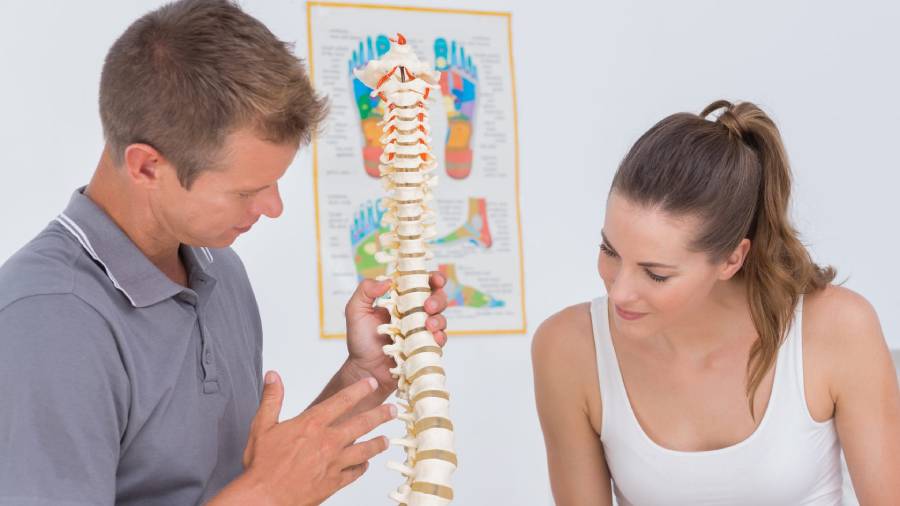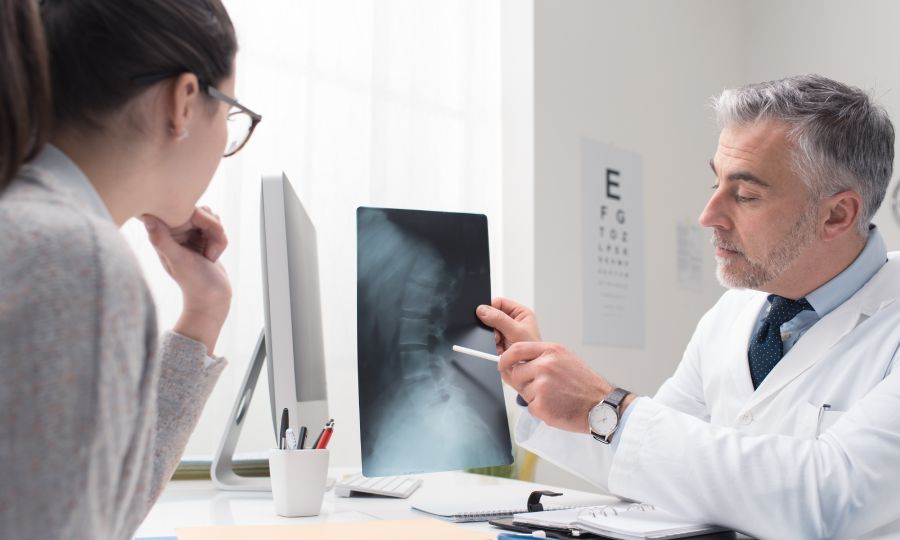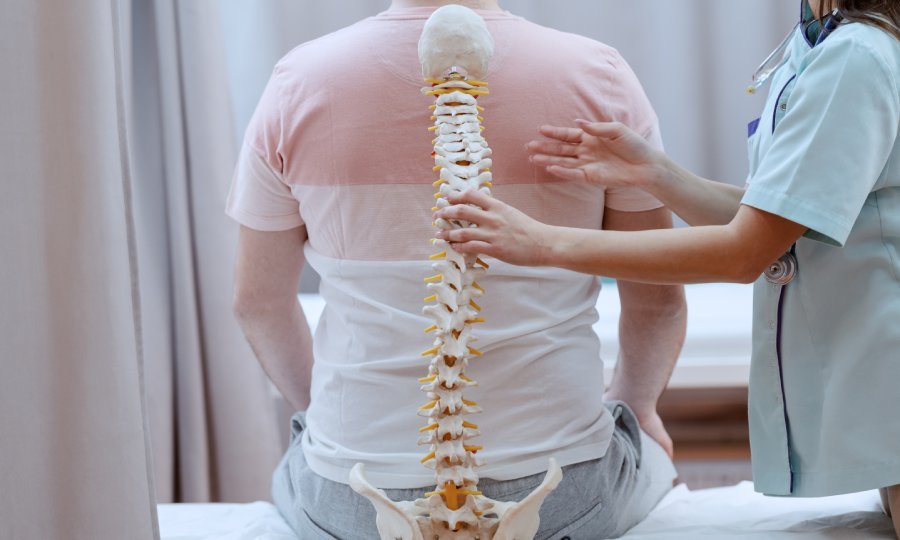Lifestyle of a modern person certainly affects his health condition. Prolonged sitting at the computer and other gadgets, office work and a sedentary lifestyle together have a significant impact on the musculoskeletal system. One of the most frequent results of such influences is posture disorders. In fact, this problem is so common that it can be told without a doubt that many of those reading this text have symptoms of poor posture. Next, we will discuss in more detail the symptoms themselves, the mechanism of their occurrence, and also dwell on the methods of their treatment.
By definition, postural disorders are a group of conditions that are characterized by a persistent deviation of the trunk from its normal position in space. These conditions are manifested primarily by a change in the physiological curves of the spine.
The curvature of the spine is divided into lordosis and kyphosis. Lordosis is a bend in which the bulge is facing forward; accordingly, kyphosis is characterized by a bend facing the bulge back. Normally, the human spine has an “S” shape: cervical lordosis, thoracic kyphosis, lumbar lordosis, sacral kyphosis. This form of the spine has an anti-gravity function, provides elasticity while running and walking, and protects the internal organs from mechanical influences. Physiological curves are supported by the natural configuration of the spinal column and muscle tone.
Posture disorders in relation to changes in the axis of the spinal column are classified as follows:
-
Posture deviations in the anterior-posterior direction, accompanied by an increase in physiological curves. (Round back)
-
Posture deviations in the anterior-posterior direction, accompanied by a decrease in physiological curves (Flat back)
-
Posture deviations in the lateral direction (Scoliosis)
Why is maintaining a healthy posture so important? In order to understand this issue, one should turn to anatomy.

Anatomical features of posture disorders
Correct posture largely depends on the thoracic spine. The importance of this region in maintaining the axis of the spinal column is easy to prove – all postural disorders include, basically, a change in the curvature of the thoracic region, which manifests itself earlier than any other symptoms.
The thoracic spine is the largest and least mobile, it consists of 12 vertebrae, each of which, unlike the vertebrae of other regions, has additional lateral joints – costovertebral, which connect the spinal column with the chest. Between the vertebral bodies, as in other regions, there are intervertebral discs that provide flexibility and cushioning throughout the spine. Their peculiarity in this region is that their height is lower, and consequently, the mobility of the region is lesser. Physiological rigidity of the thoracic spine is related, among other aspects, to the formation of the vertebral-costal rib cage and the location of the spinous processes, which overlap each other in a tiled manner, reducing freedom of movement. The largest parts of the vertebrae – the bodies, form the thoracic kyphosis. The processes located to the right of them are called spinous and overlap each other.
In recent years, the function of the upper limbs has increased when working at the computer and in the office, while the movements in the upper back are negligible. The upper back does not get the necessary mobility, so punctuate pain can appear in the center of the back or on one of the sides, and there are various reasons for this.
Punctate pain in the center of the back can occur when performing actions and movements in the upper limbs, in the absence of movement in the upper back, for example, when working in front of a computer.
In this cases, stiffness may form when a vertebra or several vertebrae move. The stiffness is manifested by a decrease of the degree of the spine movement, in its flexibility formed due to static activity. The upper back does not move for a long time, but stabilizes arm movements. Thus, the load is growing and constantly increasing. As elements of the spinal chain, the vertebrae are connected to each other, but not “glued’. Each can move in relation to the other.
Punctate pain, sometimes radiating to both sides of the chest, can be caused by several vertebrae having reduced their flexibility in relation to each other and not moving properly. The therapeutic approach in such cases requires correcting posture and developing an individual set of exercises that improves muscle synchronization and balance.

biomechanics
From a biomechanical point of view, the thoracic spine plays an important role in redistribution of the load between the upper and lower parts of the body: the diameter and height of the vertebral bodies in this region gradually increase, gradually approaching the size of the lumbar vertebrae. The main elements of maintaining stability in this region are the rib cage, intervertebral discs and ligaments. If any of these elements is impaired, the stability of the thoracic region decreases.
Another important feature of the thoracic spine is the location of the thoracic part of sympathetic nervous system here. The sympathetic system is part of the autonomic nervous system, which is also called “autonomous”. The word “autonomous” here means that it acts without the deliberate human involvement, unconsciously. The autonomic nervous system regulates the work of internal organs: the heart, kidneys, lungs, gastrointestinal tract and other organs, the work of which a human is not able to control consciously.
It is represented by two sympathetic trunks (right and left), which are formed when nerve fibers exit the spinal cord and are located on the sides of the spinal column. We will not go into the details of the difference between the sympathetic and parasympathetic nervous systems, but the following should be noted: due to the location of the trunks of the sympathetic nervous system near the thoracic spine, the occurrence of disorders in this region, including postural disorders, will lead to specific symptoms that are not observed when other regions are damaged. For example, displacement of the vertebrae in the thoracic region can lead to compression of the sympathetic nerves. As a result, the conduction of nerve impulses to the organ that this nerve innervates will be disrupted, the function of the organ will be impaired, and symptoms typical for the disorder will appear. So, for example, if the nerve is connected with the lungs, shortness of breath or coughing may occur, with the diaphragm – hiccups, according to the same principle, pains in the heart, stomach, kidneys, etc. may appear according to the same principle.
As it can be seen, posture disorders are characterized by a number of features that can complicate disease diagnostics at an early stage. That is why in any situation it is necessary to consult a qualified specialist who will help to understand the cause of the symptoms and prescribe the appropriate treatment.
Posture disorders can be either congenital or acquired. In almost 90% of cases, such disorders develop during life, and no one is immune from them.
Causes of posture disorders
The immediate reasons are:
-
Sedentary lifestyle
-
Ergonomics of a working space: poor light, uncomfortable furniture
-
Irregular distribution of weight when carrying a load (backpack or bag on one shoulder)
-
Overweight
-
Maintaining an incorrect posture for a long time
In addition, there are pathological reasons when posture disorder is a consequence of a disease: fractures, rickets, osteomyelitis and other conditions.

Types of posture disorders
Let us now review in more detail each type of posture disorders.
Round back
You are probably familiar with this posture: a person is sitting at a table, his body is tilted forward, his shoulders are tense, and his face is close to the computer screen. All of these are signs of poor posture. “Straighten your back, don’t sit hunched over!” Many of us often hear this in life. This is not surprising – a stoop or a round back is formed in a very large number of people, as a result of a sedentary lifestyle and work at the table.
Stooping (round back) is formed like a habit, which is why it is so hard to get rid of it. First, a person is in the above position only at the table, then he “takes” it with him throughout his daily life: when walking, watching TV, traveling in transport. In addition to aesthetic issues, slouching in the long term can lead to diseases of the internal organs, degenerative changes in the musculoskeletal system and muscles.
As for the physiological curves of the spine, round back is characterized by an increase in thoracic kyphosis combined with a decrease or absence of lumbar lordosis. The second one develops as an adaptive reaction in response to the first: the body tries to redistribute the load, compensatory “straightening” the lumbar spine. The shoulder girdle of a patient with a round back is raised, the head is pushed forward, the shoulder joints are somewhat adducted, the so-called “pterygoid scapulae” are often found. Often this type of posture contributes to the development of upper crossed syndrome. (UCS), described in the previous chapter
From a biomechanical point of view, the following changes occur: the pelvic girdle rotates (tilts) backwards (PPT), thus increasing the angle between the pelvis and the front of the thigh, as well as reducing the lumbar lordosis, which leads to the increased extension (extension) of the hip and knee joints, and overstretching of the anterior joint capsule, which in turn leads to an impairment of the muscle balance in the pelvic girdle. Another syndrome associated with this type of pathological posture is TOS. Thoracic Outlet Syndrome, which is characterized as the occurrence of pain in the upper limb and shoulder girdle, which may be due to compression of the neurovascular bundle by various dense structures (bones, ligaments, muscles) in the chest aperture. As the neurovascular bundle passes in a tight space between the clavicle and the first rib, as well as the scalene muscles on the neck, then with any their pathological deviation, and primarily due to incorrect posture and the resulting muscle imbalance, compression of blood vessels or nerves can occur (brachial plexus). This syndrome has neither etiological nor functional unity and therefore represents a major therapeutic problem. Therefore, a thorough medical examination should be carried out before developing a treatment plan and a set of special exercises. The results of surgical intervention are very variable and are expressed in a low percentage of success.
Flat back
A flat back is somewhat less common than a round back. In this condition, the physiological curves of the spine are smoothed out, the spinal column is almost straightened.
Flat back occurs most often as a result of weakness or underdevelopment of the muscular apparatus (postural muscles), operations on the lumbar spine or as a congenital anomaly. In the first and second cases, most often, only the lumbar bend is smoothed out, while with a congenital anomaly, all bends decrease. Other reasons for the development of a flat back include: fractures of the vertebrae of the thoracic and lumbar regions, instability of the vertebrae and stenosis of the spinal canal, ankylosing spondylitis, spondylosis of the lumbar region.
In the event of congenital flat back, with a decrease in thoracic kyphosis and the approach of the spinal column to the internal organs, pain may occur associated with squeezing the heart and large vessels. If it is the acquired disorder, when the lordosis of the lumbar spine is smoothed out, the center of gravity of the body shifts, as a result of which patients bend their legs to maintain balance in a standing position. This position is unusual for the body: the muscles are in constant tension. As a result, over time, pain in the back, lower extremities, contractures develop – limitation of movement in the joints. The same pains are also typical of the upper sections of the spine, where, due to the smoothing of the curves, the muscles of the head, neck and shoulder girdle are overstrained.
One of the complications of a flat back is directly related to the biomechanics of a straight spine: in the absence of curves, shock absorption function is not fully implemented. As a result of this, the blows perceived by the spine, for example, during a run or a fall, are not softened, being transmitted directly to the skull, and from there to the brain. Among other things, a flat back often leads to compression of the roots of the spinal cord and the appearance of neurological symptoms.
Scoliosis
The occurrence of scoliosis – a curvature of the spine in the frontal plane, often becomes the cause of the muscular imbalance that we encounter in our lives.
The causes that can lead to the development of scoliosis include, for example:
-
Prolonged asymmetric muscle tension – work of the leading limb: playing sports (tennis), working at the machine, uneven distribution of weight when carrying a load (bag on one shoulder), sitting at a table in an uncomfortable position for a long time, etc.
-
Flat feet and difference in leg length.
-
Weakness of the pectoral girdle
-
Damage to the spine (injuries, degenerative changes, tumors)
Scoliotic or asymmetric posture is a postural defect characterized by a bending of the spinal column to the right or left (more often) from the midline, in which, unlike scoliosis, there are no signs of twisting of the vertebrae (muscle ridges and costal hump).
Classification of scoliosis
There are several classifications of scoliosis
Two groups can be distinguished: structural scoliosis (curvature, which is accompanied by twisting of the vertebrae) and non-structural (not accompanied). Structural scoliosis is most often the result of trauma (traumatic scoliosis), a congenital anomaly (osteopathic), or a metabolic disorder (such as rickets).
Non-structural scoliosis is more common and is associated with posture disorders, muscle imbalance, different lengths of the lower limbs (as compensation) or reflex (associated with the forced position of the patient in pain). A common type of scoliosis is compensatory, when, for example, a bend in one region of the spine (thoracic) is compensated by a deflection in another region (lumbar) in the form of the letter S in the frontal plane.
Taking into account the location of the curvature of the spine, there are:
-
Cervical-thoracic
-
Thoracic
-
Thoracic-lumbar
-
Lumbar
-
Lumbosacral
The first signs of scoliosis of the thoracic spine:
-
Discomfort and pain in the area of curvature.
-
Headaches or dizziness related to compression of the vertebral arteries passing along the sides of the spinal column, supplying the brain.
-
Irritability and fatigue.
-
Neurological symptoms related to compression of the nerve roots.
-
Uneven arrangement of the shoulder blades and shoulders – one higher than the other.
Methods for treatment of scoliosis can be both conservative and surgical, depending on how the disease progresses. As conservative methods of treatment, special gymnastics and a set of postural exercises, swimming can be indicated. Wearing corsets or orthopedic insoles are indicated if scoliosis occurs due to the fact that one limb is shorter than the other.

Physiological and functional problems
What physiological and functional problems can result from problematic posture?
- Permanent structural changes caused by poor posture cause mechanical stretching of the joint capsules, ligaments, tendons and muscles that are sensitive to overstretching – and as a result can cause pain, instability, muscle imbalance, expressed in the weakening of the postural muscles.
- Incorrect posture also causes dysfunction of the respiratory system. Breathing is carried out mainly in the upper part of the chest, with reduced involvement in the process of the lower part of the chest and lower ribs. Diaphragmatic breathing is also difficult.
- Poor posture can also lead to neck pain, headaches and dizziness, which in turn increases the likelihood of falls and traumatic injuries.
- An arched posture in the upper back can affect the contraction of the anterior muscles and the weakness of the posterior muscles. In this case, a patient will be recommended to correct the wrong posture, taking into account the anatomical structure and the affected muscles.
Treatment in these cases may include stretching the anterior muscles such as the superficial and deep pectoral muscles, anterior neck muscles, abdominal muscles, and other muscles that may contribute to this posture.
In addition, the muscles of the back are strengthened, which include the stabilizing muscles of the shoulder blades and shoulder, the muscles of the trunk and neck.
There is a misconception that shortened, spasmodic muscles are strong, but this is not true. When rehabilitating the muscular apparatus, it is important to remember that stretched (elongated) muscles, just like shortened ones, are weak!!
Video: “Exercises for the Rehabilitation of Posture Disorders”
SET OF EXERCISES №1 TO IMPROVE POSTURE. ROUND BACK (SLOUCHING)
For additional information about exercises for the rehabilitation of Posture disorders you can watch a video demonstrating exercises and rehabilitation recommendations.
Treatment of posture disorders
The key to correct posture is the good quality prevention of disorders. The main advice for the prevention of postural disorders is the adherence of work and rest regime. Since in many cases , postural defects develop due to a long stay in non-physiological regular posture – when working at a computer or machine, it is necessary to take periodic breaks (the last 10 minutes of each hour) to change the posture, stretch and relax the muscles of the body.
If postural disorders have already developed, a qualified specialist in of physiotherapy and rehabilitation can help you. He will prescribe a set of special exercises, physiotherapy, massage for you, which will allow you to eliminate muscle imbalance and strengthen the musculoskeletal system. The program is compiled individually and includes both static and dynamic exercises. Swimming and hydrotherapy are also recommended.
Physiotherapy primarily focuses on recovering muscle balance, which improves a patient’s posture, which is not always related to pain, but in many cases, it contributes to pain in the upper back more often than in other parts of the body.
Corsets, chest belts, reclinators and thoracolumbar correctors can be used for passive posture correction.
As a preventive measure to prevent the progression of posture disorders, it is recommended to: equip properly the workplace ergonomically, perform a set of preventive and strengthening physical exercises, select correct types of physical activity and load.

CHECK OUT THE DEMO VERSION OF OUR SETS OF EXERCISES FOR THE REHABILITATION OF POSTURE DISORDERS ON YOUTUBE
Our website presents the following sets of exercises for the rehabilitation of Posture disorders:





